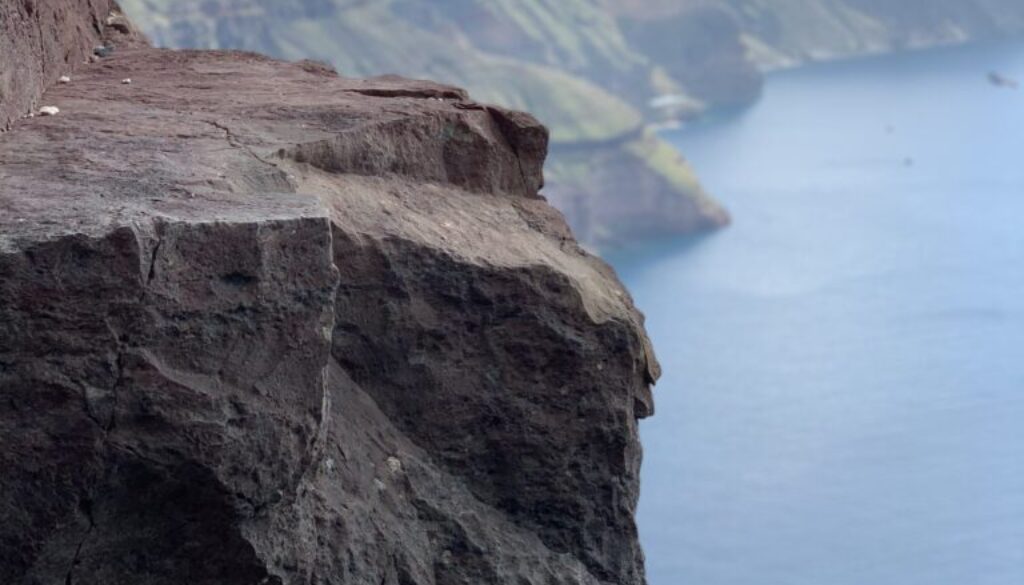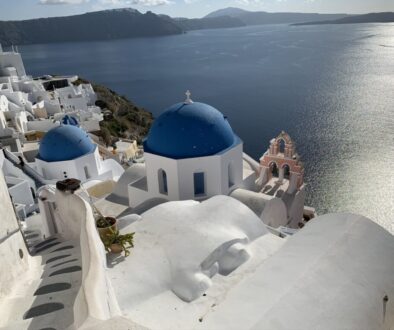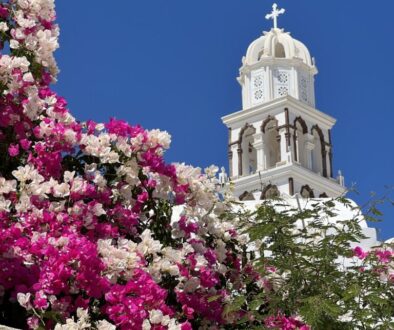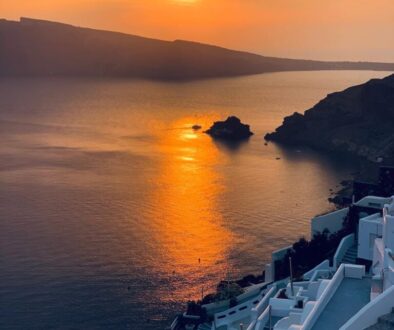The Natural Events That Shaped Santorini: A Deep Dive Into Its Unique Landscape
Santorini, an island steeped in geological and historical drama, owes its breathtaking beauty to powerful natural forces. From the towering caldera cliffs and volcanic islets like Skaros Rock to underwater marvels such as Columbos, this Aegean gem is a living testament to millennia of volcanic activity, seismic shifts, and erosion. In this expanded exploration, we’ll uncover every detail about the natural events that shaped Santorini, explaining how its terrain and culture have evolved together over time.
Santorini’s Volcanic Origins: The Birth of an Island
Santorini is part of the Hellenic Volcanic Arc, a chain of volcanic islands that includes Milos, Kos, and Nisyros. Millions of years ago, volcanic activity in this region led to the gradual formation of the original Santorini landmass, known as Stroggili, or “the round one.”
How Volcanic Activity Built Santorini
- Plate Tectonics: The collision and subduction of the African and Eurasian tectonic plates generated intense volcanic activity in the Aegean region.
- Layered Eruptions: Multiple eruptions over hundreds of thousands of years laid down layers of lava, pumice, and ash. These layers, visible on the caldera cliffs, provide a visual timeline of the island’s fiery past.
The Minoan Eruption: Shaping Santorini’s Core
One of the most significant natural events in the island’s history occurred around 1600 BCE: the Minoan eruption, one of the most powerful volcanic explosions in recorded history. This event reshaped the island and profoundly influenced the surrounding region.
The Impact of the Minoan Eruption
- Caldera Collapse: The eruption emptied the magma chamber beneath Stroggili, causing the island’s center to collapse into the sea, forming the caldera. Today, this steep-walled, water-filled crater is one of the defining features of Santorini.
- Massive Pumice and Ash Deposits: Ash deposits from the eruption spread across the eastern Mediterranean, reaching as far as Turkey and Egypt. These layers buried the island in a protective shell, preserving historical sites like Akrotiri.
- Tsunamis and Regional Impact: The eruption triggered massive tsunamis, believed to have contributed to the decline of the Minoan civilization in Crete.
The Caldera Cliffs: A Testament to Santorini’s Volcanic Past
The caldera cliffs, rising up to 300 meters above sea level, reveal the island’s geological history in layers of red, black, and white rock. These cliffs, carved by both volcanic activity and erosion, are one of Santorini’s most iconic features.
Key Highlights of the Caldera Cliffs
- Multicolored Layers: Each color corresponds to different volcanic materials—white pumice, black basalt, and red volcanic ash.
- Cliffside Villages: Settlements like Fira, Oia, and Imerovigli cling to the cliffs, offering spectacular views of the caldera.
Volcanic Islets: Nea Kameni and Palea Kameni
Santorini’s caldera remains geologically active, as evidenced by the formation of the volcanic islets Nea Kameni and Palea Kameni. These islands are the result of more recent eruptions.
Exploring the Volcanic Islets
- Nea Kameni:
- Formed by eruptions between 1570 and 1950, Nea Kameni is the younger of the two islets.
- Visitors can hike its trails to see steaming fumaroles, lava fields, and sulfur deposits.
- The view from its summit offers unparalleled perspectives of the caldera.
- Palea Kameni:
- Older and smaller, Palea Kameni is known for its hot springs, where the mineral-rich waters are believed to have therapeutic properties.
Columbos: The Underwater Volcano
Located 8 km northeast of Santorini, Columbos is an underwater volcano that remains active and closely monitored by geologists.
Facts About Columbo
- Eruption History: Its last major eruption in 1650 AD created seismic waves and caused significant damage on Santorini.
- Modern Activity: Columbo’s vent is still active, releasing gases and thermal energy that sustain unique marine ecosystems.
Skaros Rock: A Geological and Cultural Landmark
Skaros Rock, a towering volcanic promontory near Imerovigli, is one of the most prominent features of Santorini. It served as both a natural fortress and a strategic location throughout history.
Significance of Skaros Rock
- Geological Formation: Skaros Rock was formed during the island’s volcanic phases and later shaped by wind and erosion.
- Historical Importance: It was a fortified medieval settlement during the Byzantine era, offering protection from pirate attacks.
- Hiking Destination: Today, it’s a popular spot for hiking, with trails leading to its summit and breathtaking views of the caldera.
The Role of Earthquakes: Shaping the Island’s Terrain
Santorini’s proximity to tectonic plate boundaries makes it prone to earthquakes, which have contributed to its fragmented landscape.
Seismic Transformations
- Reshaping the Island: Over centuries, tectonic activity has caused parts of the island to sink into the sea, while other areas have risen.
- Architectural Adaptations: Traditional cave houses and cliffside structures are designed to withstand earthquakes, showcasing the resilience of Santorini’s inhabitants.
Erosion’s Quiet Influence
While volcanic eruptions and earthquakes dominate Santorini’s history, erosion has played an equally important role in sculpting its unique features.
How Erosion Has Shaped Santorini
- Beaches: Erosion of volcanic materials created Santorini’s distinctive beaches:
- Red Beach: Formed from oxidized iron-rich rocks.
- Black Beaches: Perissa and Kamari feature basaltic sand and pebbles.
- White Beach: Limestone cliffs contribute to its striking white appearance.
- Cliffs and Caves: Wind and rain carved dramatic cliffs and caves, many of which are now used as homes or hotels.
Santorini’s Fertile Volcanic Soil
The ash and pumice from Santorini’s eruptions have created nutrient-rich soil, supporting unique agriculture despite the island’s dry climate.
Agricultural Highlights
- Assyrtiko Grapes: This indigenous grape variety thrives in the volcanic soil, producing crisp, mineral-rich wines.
- Cherry Tomatoes: Known for their intense flavor, these tomatoes are a Santorini specialty.
- Fava Beans: A staple of local cuisine, Santorini’s fava is renowned for its creamy texture.
Experiencing Santorini’s Natural Wonders
Exploring the natural events that shaped Santorini can be a deeply immersive experience. Consider these activities to connect with the island’s geological history:
- Hiking the Caldera Rim:
- The trail from Fira to Oia offers stunning views of the caldera cliffs and Skaros Rock.
- Boat Tours:
- Visit Nea Kameni and Palea Kameni, and sail over the submerged crater of Columbos.
- Akrotiri Archaeological Site:
- Discover the preserved Minoan settlement buried under layers of volcanic ash.
- Wine Tours:
- Visit local wineries to see how volcanic soil influences Santorini’s world-class wines.
- Beach Hopping:
- Explore the colorful beaches and learn about the geological processes behind their formation.
Conclusion: Santorini, A Geological Masterpiece
Santorini’s stunning landscapes are more than picturesque—they are a living record of the island’s tumultuous geological past. From the formation of its caldera cliffs to the enduring presence of Columbos and Skaros Rock, every corner of the island tells a story of resilience, transformation, and natural beauty. Exploring Santorini’s heart through its volcanic history provides a deeper appreciation for this Aegean marvel. Whether you hike its cliffs, sail its caldera, or wander its ancient ruins, Santorini is a destination where nature and history converge in breathtaking harmony.



